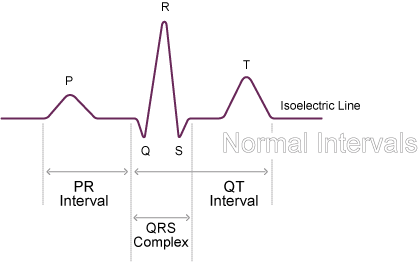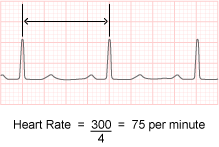Cardiology Teaching Package
A Beginners Guide to Normal Heart Function, Sinus Rhythm & Common Cardiac Arrhythmias
Normal Duration Times for the 3 Waves
As well as being able to recognise the 3 different parts of the cardiac cycle, each stage should be completed within a specific time period to be considered normal. Although these measurements are in fractions of a second, the ECG paper allows you to count the time in small squares. Measurement in small squares is more universally used than tenths and hundredths of seconds.
The P-R Interval
The first measurement is known as the "P-R interval" and is measured from the beginning of the upslope of the P wave to the beginning of the QRS wave. This measurement should be 0.12-0.20 seconds, or 3-5 small squares in duration. The second measurement is the width of the QRS which should be less than 3 small squares, or less than 0.12 seconds in duration.
Image: Normal Intervals

- P-R interval = 0.12 - 0.20 sec (3 - 5 small squares)
- QRS width = 0.08 - 0.12 sec (2 - 3 small squares)
- Q-T interval 0.35 - 0.43 sec
- * The PR interval should really be referred to as the PQ interval; however it is commonly referred as the PR interval
Regularity
The third measurement is to check for regularity. This can be done by measuring the "p-p interval" or the "R-R interval". To measure the P-P interval, place the edge of a piece of paper along the line of the rhythm and mark the centre of 2 consecutive P waves. Compare this measurement with the next 2 P waves. If the measurements are the same then the rhythm is regular.
Image: Calculting the heart rate when the rhythm is regular
- There are 300 large squares per minute
- If the rhythm is regular count the number of large squares between two QRS complexes and divide it into 300

Similarly, to measure the R-R interval, measure the distance between the peaks of 2 consecutive QRS complexes (see above). Compare with the next 2. If they match then the rhythm is regular.
IS it Sinus Rhythm?
To ascertain whether a rhythm is sinus or not you need to be able to identify key features.
- There must always be a p wave.
- The P wave should be a rounded shape
- Each P wave should be the same shape
- Each P wave should be followed by a QRS
- The P-R interval should be 3-5 small squares and constant
- The rhythm should be regular.
You do not need to be able to recognise a "T wave" for it to be sinus rhythm. Many abnormalities obscure the t wave. Suffice to say, if the patient is alive then the ventricles are definitely repolarising.
